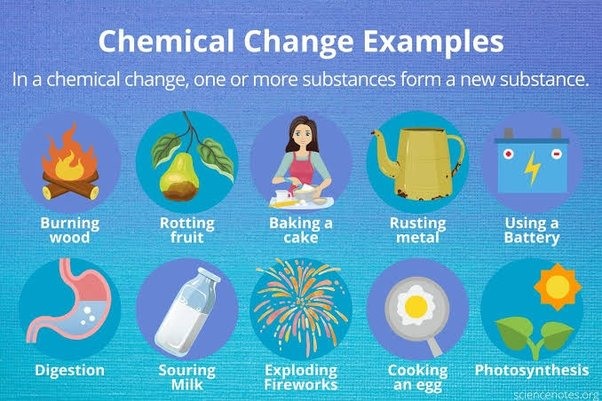A chemical change is more than just a simple alteration; it's a profound transformation at the molecular level. When substances undergo a chemical change, they undergo a metamorphosis, fundamentally altering their molecular structure and composition. This process results in the emergence of entirely new substances with properties that differ significantly from those of the original materials. Chemical changes are characterised by the formation of new bonds, the release or absorption of energy, and irreversible modifications to the chemical composition of the substances involved.
Read More: Physical and Chemical Changes: Definition, Characteristics and Example
What is a Chemical Change?
A chemical change occurs when substances transform into entirely new materials with distinct properties, resulting in the formation of one or more new substances. This transformation can happen through synthesis, where substances combine to create new compounds, or decomposition, where a substance breaks down into simpler components. An example of a chemical change is oxidation, which triggers various chemical reactions. Chemical changes are typically irreversible unless further chemical reactions occur. Examples include dye development altering color and chemical reactions modifying hair structure. Chemical changes are categorized as organic, inorganic, or biochemical transformations.

Image Source: Quora
Key Characteristics of Chemical Reactions:
- Irreversibility: Unlike physical changes, which are often reversible (like melting ice), chemical changes are generally irreversible. The original substances cannot be recovered through simple physical means.
- Energy Transformations: Chemical changes are often accompanied by energy changes, either releasing (exothermic) or absorbing (endothermic) energy. This energy is involved in breaking and forming chemical bonds.
- Formation of New Substances: The hallmark of a chemical change is the creation of one or more new substances with properties different from the original materials. This transformation occurs due to the rearrangement of atoms and the formation of new chemical bonds.
- Observable Changes: While not always evident, chemical changes can often be observed through changes in color, the formation of gases (bubbles), the formation of precipitates (solids), the release of light or heat, or the emission of a distinct odor.
Check: Pure and Mixed Substances: Definition, Characteristics and Example
Chemical Changes in Everyday Life
- Baking a cake: The mixing of ingredients, the heat application, and the resulting cake are all signs of chemical changes.
- Digestion: Our bodies break down food into simpler substances through a series of chemical reactions, releasing energy for our bodies to use.
- Rusting of iron: Iron reacts with oxygen in the presence of moisture, forming iron oxide (rust), a new substance with different properties.
- Burning wood or paper: These substances react with oxygen to produce carbon dioxide, water vapor, and ash – completely new substances.
- Photosynthesis: Plants convert sunlight, water, and carbon dioxide into glucose and oxygen through a complex series of chemical reactions.
Video Lessons Link For Students
Comments
All Comments (0)
Join the conversation